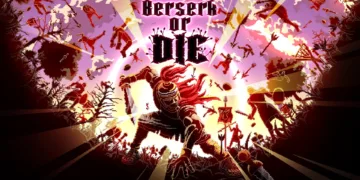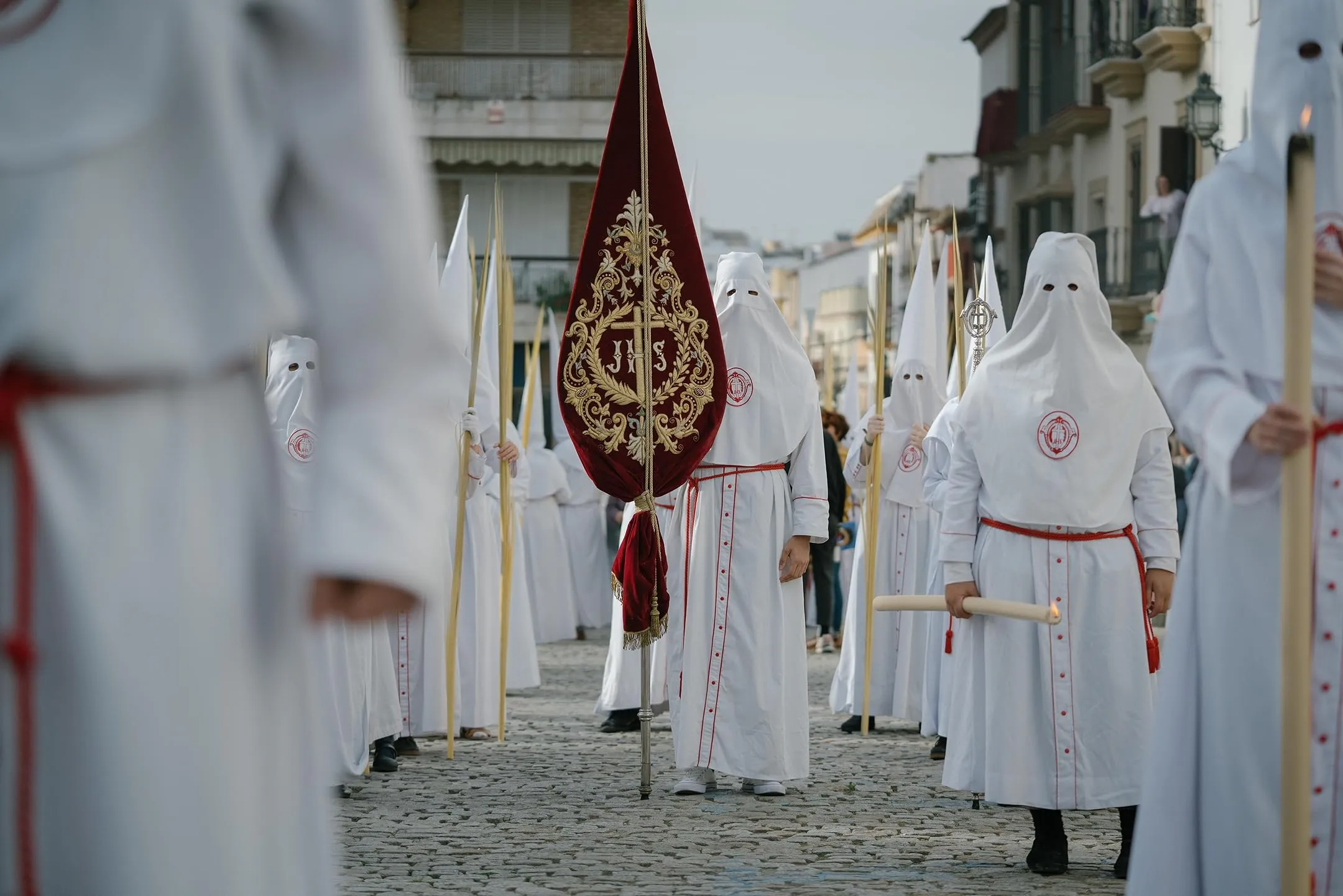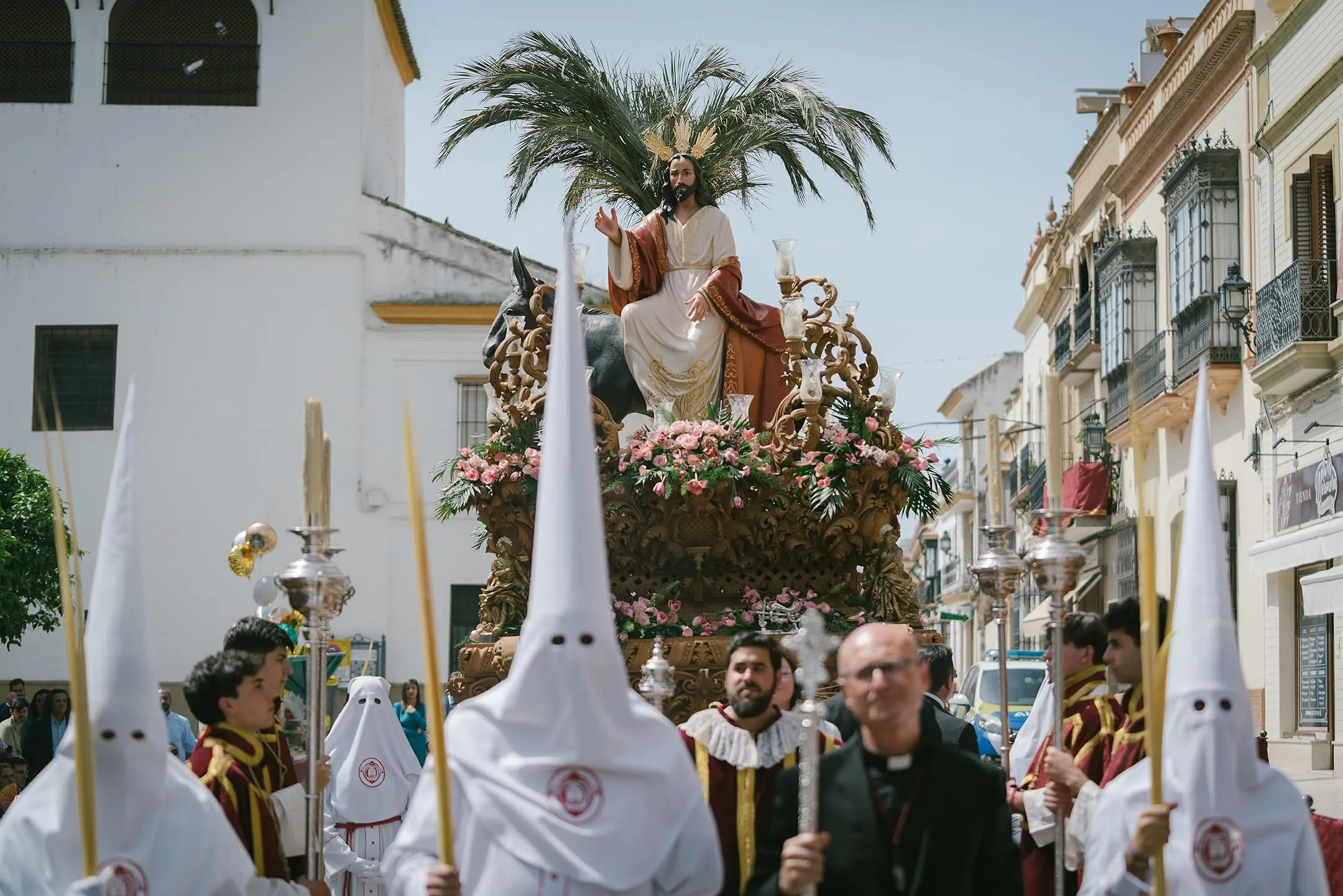From its opening shot of a saffron‑tinged altar to the staccato percussion of Palm Sunday drums, When No One Sees Us announces itself as a six‑part Spanish–American crime drama on Max. It marries the blunt mechanics of a police procedural with a meditative spiritual mystery and a countryside noir mood (cue the buzzing cicadas). The series centers on Lt Magaly Castillo, a cyber‑investigator transplanted from Chicago’s digital warrens, and Sgt Lucía Gutiérrez, a Civil Guard veteran whose public duty collides with private loyalties.
The catalyst arrives in brutal fashion: a respected professor performs seppuku in the dead of Holy Week, his torso a grotesque canvas of ritual devotion. Soon after, a new street drug provokes near‑hallucinogenic zeal among Nazarenes in procession, while the vanishing of U.S. Airman Miles Johnson and a local teen weaves modern geopolitics into a small‑town enigma.
There is a gravity to the show’s pace—each long take seems to exhale Andalusian air—but a sting of minimalism prevents tedium. Silences resonate as sharply as gunshots. Under Enrique Urbizu’s watch, the camera lingers on crucifixes and cracked military IDs alike, suggesting that faith and power fracture in similar ways. Hints of Nordic‑noir restraint (think somber stares and moral fog) underscore a refusal to sensationalize, even when gore obliges our gaze.
Echoes of Liturgy and the Gunmetal Horizon
Nestled among whitewashed houses and sun‑baked plazas, Morón de la Frontera stands in for the sacred heart of Andalusia—and, paradoxically, as the doorstep to a sprawling U.S. military base (hard to imagine El Cid trading barbed wire for rosary beads). Palm Sunday arrives like clockwork, with Nazarenes in hooded habits shouldering pasos through narrow streets. The procession is a living mnemonic of centuries‑old penitence, even as local youth Snapchat the smoke from incense.
Here, ancient ritual collides with twenty‑first‑century hegemony. The roar of transport jets shatters the hush of monastic chants (a shrill reminder that the global arms trade has no off‑season). Tourism dollars bolster the town’s coffers—but at the cost of a “pact of silence” worthy of a rural omertà: no questions asked, lest the annual influx of t-shirts and sangria cease.
Visually, the series bathes in golden hour and twilight. Dawn breaks like an unspoken prayer; dusk creeps in with ominous calm. Candlelight dances on stone façades, while the subdued musical score—bells tangled with distant drumbeats—makes the air feel almost sentient.
Violence erupts without warning. A sudden scream rips through a cathedral‑quiet scene.
Yet it is the hush between moments that bites hardest. A mother’s sigh at breakfast. A sergeant’s pensive cigarette on a balcony. These still frames impart more unease than any plunge of a sword. In this “ritual noir” landscape, solemnity and savagery exist on the same axis—one feeding the other.
Weaving Riddles and Rhythmic Suspense
Season 1 unfurls like a ritual text inscribed in six chapters. Episode 1 lays three enigmas side by side—the professor’s seppuku, the Nazarena‑induced visions, the missing airman—while introducing Castillo and Gutiérrez (partners of convenience, skeptics by trade). By mid‑season, these threads intersect: drug theory bleeds into ancient rites, military bureaucracy collides with local codes. Episodes 5 and 6 bring the puzzle full circle, revealing conspiracies that feel less like plot twists and more like inevitable reckonings.
Notice how forced cliffhangers are banished. Instead of abrupt shocks, tension simmers in loaded glances and unspoken alliances. It’s what one might dub “quiet climaxing”—an almost anti‑thriller choice that rewards patience (and perhaps a stronger constitution).
Two investigations run in parallel: Castillo chases Johnson’s digital breadcrumbs, Gutiérrez deciphers clues in village lore and the teenager’s disappearance. The subplot around “Shēdo,” the professor’s Bushidō‑infused alter ego, amplifies the sense that every character is a cipher, every ritual a coded message.
Pacing is elastic. Procedural beats loosen in favor of atmospheric lulls—dawn’s hush before a procession, a mother’s pause before confession. Then, without warning, intensity spikes: a sudden scream in a cathedral courtyard, a blade slicing through flesh.
Visual leitmotifs tether story and symbolism. That small Buddha statue (first seen in Episode 1) reappears in unexpected corners, as if to remind us that spirituality and violence share a shadowy genealogy. Likewise, the cloth‑wrapped sword recurs like a bloodstained bookmark, marking the narrative’s most portentous passages. Early hints—anomalous toxicology results, a colonel’s evasive remarks—pay off later as proof that law and faith often operate under the same veil of secrecy.
Architects of Doubt and Duty
Mariela Garriga’s Lt Magaly Castillo is a study in disciplined dissonance. A cybersecurity specialist among monks, she navigates cultural and institutional fault lines with the precision of a scalpel (only less messy). Her outsider status echoes Cold War-era intrigue—an American operative in Andalusian terrain evoking memories of U.S. bases in post‑Franco Spain—and raises questions about sovereignty and surveillance.
Castillo’s emotional armor cracks under the weight of classified intel: each moral quandary becomes a miniature battlefield between duty and conscience. Garriga’s performance is quietly electric—what one might term “stoic dynamism”—as she shifts from clipped formality to hesitant empathy.
By contrast, Maribel Verdú’s Sgt Lucía Gutiérrez embodies rootedness, a local insider confronted with the weight of lineage and law. She treads a narrow path between Civil Guard protocol and the demands of motherhood: the daughter’s bedroom arguments become as charged as any crime scene. Verdú balances iron‑clad authority with fragile vulnerability, suggesting that policing and parenthood share an impossible standard. In her, tradition and modernity are not antagonists but uneasy roommates.
Austin Amelio’s Sgt Andrew Taylor offers a touch of levity amid ritualistic dread (an “accidental Bridgerton” in uniform). He starts as comic relief—the mustache alone seems to wink at genre clichés—but evolves into a genuine cultural interlocutor, translating military imperatives into local idioms.
Lt Col. Seamus Hoopen (Ben Temple) stands at the opposite end: unflinching pragmatism, the quintessential “brass‑hat” aloofness. His offhand dismissals of the Civil Guard recall real‑world power asymmetries, where national security often trumps communal justice.
The supporting ensemble—brotherhood members, a reticent café owner, furtive teenagers—serves as a living chorus of collective memory. Their superstitions and silences gesture toward Spain’s rural omertà, where communal survival can mean complicity.
Castillo and Gutiérrez share a partnership defined by “procedural liminality”—caught between data‑driven precision and intuition‑rooted instinct. Their dialogue can feel as stiff as ritual garb, yet intermittently human (and even self‑deprecating). Emotional resonance flickers unpredictably—sometimes absent, sometimes blinding—reminding us that trust, like faith, is never guaranteed.
Ritual Chiaroscuro and the Art of Stillness
Urbizu’s signature lies in what doesn’t happen: muted gestures, long takes (like a monk’s vow of silence), and camera moves so deliberate they feel carved from stone. Every frame reads as a meditation on ritual—no swish pans or frantic cuts—reinforcing a slow‑burn tempo that makes even an empty plaza seem charged.
Cinematographer Óscar Durán bathes the town in ochre and umber, only to punctuate it with the shock of crimson blood or the ghostly white of penitents’ habits. Processions unfold in wide compositions, the human tide moving as one organism, a “liturgical tide” caught between devotion and dread. Then the lens snaps tight: a quivering lip, a hand gripping a rosary (or a blade), forcing the viewer into intimate confession.
Production design honors Andalusian devotion with painstaking accuracy: ornate pasos, hooded capirotes, incense that seems almost tactile. Contrast that with the base’s brutalist corridors—concrete walls humming with fluorescent light—and you witness tradition pressed against modern power structures. The professor’s shrine, garlanded with Japanese talismans and Spanish novenas, becomes an emblem of cultural cross‑pollination gone awry.
Sound design is ruthless in its restraint. A single church bell toll. Footsteps echo in a cavernous hall. Then silence. This “diegetic minimalism” swaps cliché scores for ambient unease, proving that sometimes the loudest statement is no statement at all.
Sacred Codes and the Anatomy of Transgression
The blood‑stained satin of Holy Week processions faces off with the neon haze of Nazarena (the drug whose very name feels like a blasphemous hymn), performing a liturgical inversion that’s both unsettling and eerily persuasive. The professor’s seppuku sequence—Bushidō slashed onto Andalusian soil—becomes a study in cultural misappropriation, proof that ritual can metastasize when siphoned from its origin.
Beneath the town’s sun‑bleached façades lies a memory palimpsest: Franco’s long shadow still haunts whispered pilgrimages. The local pact of silence is more than communal self‑defense; it channels a national struggle to reckon with buried truths. Modern lawmen and ancestral codes clash as though upholding honor demands intergenerational warfare.
Characters grapple with faith, guilt, and redemption in ways that mirror collective confessionals. A priest’s woman‑to‑woman counsel, a sergeant’s sleepless prayer—each moment tests moral muscle. In this landscape, hope flickers like a votive candle—bright but precarious. Some seek atonement through confession, others through cold verdicts meted out in courthouse corridors.
Power structures groan under hefty contradictions: fighter jets roar above capirotes, the U.S. base’s concrete walls dwarfed by chapel bells. Tourism revenues and public safety duke it out like rival religious orders—one preaches profit, the other preaches justice.
Outsiders define identity here. Castillo watches through screens; the missing airman drifts between duty and exile; “Shēdo,” the professor’s alter ego, negotiates East and West. Their very existence questions what anchors us to place and belief.
Portents and Paths Ahead
Strengths stand out in almost every frame: the series drapes itself in religious gravitas, Garriga and Verdú hold the screen like rival icons, and the thematic currents run deep. Yet at times the show’s restraint veers into frigidity, and the slow pace can feel like a sedate procession that never quite breaks into a run. It resembles a tasting menu served in thimbles—exquisite but occasionally leaving you with an appetite for more urgency.
This approach breathes new life into rural noir, placing spiritual inquiry at the center of a crime drama in a way that few streaming titles dare. It evokes the patient intensity of 1970s thrillers set in tight‑knit communities (think Sorcerer meets The Wicker Man), while reflecting real‑world frictions between local tradition and global power (the U.S. base hovering like a modern fortress).
Watch it if you hunger for mysteries that refuse easy solutions—or if you relish a show that feels as much an anthropological case study as a detective yarn.
Season 2 could deepen the bond between Castillo and Gutiérrez, pry open the base’s locked doors, or unearth new ritualistic sacrifices. Will this slow‑burn crucible of faith and violence mark the next wave of genre television? It just might.
Full Credits
Director: Enrique Urbizu
Creator: Daniel Corpas
Writers: Arturo Ruiz, Luis Caballero, José Antonio Valverde, Germán Aparicio, Isabel Sánchez
Executive Producers: Antonio Asensio, Paloma Molina, Salvador Yagüe, Miguel Salvat, Antonio Trashorras, Patricia Nieto
Producers: Zeta Studios, Warner Bros. Discovery
Cast: Maribel Verdú (Lucía Gutiérrez), Mariela Garriga (Magaly Castillo), Austin Amelio (Andrew Taylor), Ben Temple (Colonel Seamus Hoopen), Dani Rovira (Víctor Martín), Lucía Jiménez (Macarena), Eloy Azorín (Ramón), María Alfonsa Rosso (Carmen), Numa Paredes (Claudia), Virginia de Morata (Ana Cepeda), Ana María Vivancos (Emilia Navas), Carlos Beluga (Leiva), Lorca Gutiérrez Prada (Samuel), Abril Montilla (María Yagüe), Daniel John Silva (Sergeant Miller), Michael John Treanor (Airman Andersen), Rob McLoughlin (Lt. Sgt. McKenzie), Juanfra Juárez, María Cabrera, Natalia Braceli (Prima Leiva), Thomas King (Soldado)
Director of Photography (Cinematographer): Unax Mendía
The Review
When No One Sees Us Season 1
A sun‑drenched slow‑burn that trades breakneck thrills for ritualistic tension, When No One Sees Us offers a richly layered investigation into faith, power, and secrecy. Mariela Garriga and Maribel Verdú anchor its austere beauty, even if the deliberate pacing occasionally chills momentum.
PROS
- Rich, ritual‑laden atmosphere
- Nuanced lead performances
- Thoughtful thematic depth
- Striking visual and sound design
- Fresh take on rural noir
CONS
- Deliberate pacing can drag
- Emotional reserve may feel cold
- Secondary characters lack depth
- Sparse scoring risks monotony
- Slow reveals test patience





















































